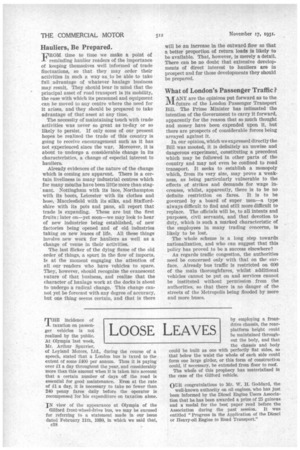ITIBE incidence of taxation on passenger vehicles is not realized
Page 40

Page 41

If you've noticed an error in this article please click here to report it so we can fix it.
by the public. At Olympia last week, Mr. Arthur Spurrier, of Leyland Motors, Ltd., during the course of a speech, stated that a London bus is taxed to the extent of some £400 per annum. Thus it is paying over D. a day throughout the year, and considerably more than this amount when it is taken into account that a certain number of days off the road is essential for good maintenance. Even at the rate of £1 a day, it is necessary to take no fewer than 240 penny fares daily before the operator is recompensed for his expenditure on taxation alone.
TN view of the appearance at Olympia of the Gilford front-wheel-drive bus, we may be excused for referring to a statement made in our issue dated February 11th, 1930, in which we said that, e18 iby employing a front, drive chassis, the rearplatform height could be maintained throughout the body, and that the chassis and body could be built as one with perfectly flat sides, so that below the waist the whole of each side could form one large girder, or this form of construction could, if necessary, be extended from floor to roof. The whole of this prophecy has materialized in the case of the Gilford vehicle.
OUR congratulations to Mr. W. H. Goddard, the well-known authority on oil engines, who has just been informed by the Diesel Engine Users Association that he has been awarded a prize of 25 guineas and a medal for the best paper read before the Association during the past session. It was entitled "Progress in the Application of the Diesel or Heavy-oil Engine to Road Transport." ONE of the most striking preliminaries to the Com mercial Motor Show was the entry of several of the largest vehicles into Olympia. The gangways offer none too large a space for a vehicle of 7-ft. Crin, width, and to manceuvre a double-decker down a gangway and then to reverse it into position on the stand, generally turning through at least one right-angle in so doing, is a task calling for a good degree of skill on the part of the driver, and for a really manceuvrable vehicle.
One of the neatest pieces of work was the putting into position of the six-wheeled Mercedes-Benz, with its huge Duramin body. It had to take its place when other stands were full, and it is probable that 75 per cent. of the drivers of private cars would have found the matter rather unpleasantly difficult for them, but this big six-wheeler was manceuvred with surprising skill and ease. This vehicle has 13.5-in. tyres on all wheels.
ON the whole, the lay Press has given generous and fairly accurate treatment to the Commercial Motor Exhibition. One rather amusing instance, however, was that of a Sunday paper, which referred to the Karrier three-wheelers as " tugs " and included a statement to the effect that some of the largest six-wheelers are now equipped with tyres of no less than 20 ins, in diameter! Modern methods of tyre description are misleading to the uninitiated.












































































































